Trillium persistens is perhaps the rarest Trillium species around, being found only in a four-square-mile area in the mountains of Georgia and South Carolina. This area is located near Tallulah Gorge; a deep canyon with steep cliffs which were carved eons ago by the Tallulah River. The river marks a portion of the border between Georgia and South Carolina and becomes the Tugaloo River, downstream. The flowers of Trillium persistens that we photographed on this trip, grow on a tributary of the Tugaloo River called Panther Creek.
Although not the fanciest or showiest species of Trillium, it is so rare that it has been placed on the federal endangered species list. The US Fish and Wildlife Service states, “Juvenile persistent trillium plants are single-leaved until the 6th year when a three-leaved plant is produced. As with other slow-growing trillium species, it takes 7 to 10 years to produce a mature, 3-leaved, flowering plant. Some persistent trillium plants may possibly live for 30 or more years.”
The first thing I have to mention about the trip is the exceptional couple of guys that accompanied me. It was cold and rainy when I met my flickr buddy, Alan Cressler, and my Atlanta Botanical Garden friend, Steve Bowling.The day (in fact, the entire weekend) started out with pouring rain.
It was barely light outside when I packed my gear in the truck and started the drive west toward Toccoa, Georgia — the hopping off point for this field trip. Just when I crossed over the Seneca River from South Carolina into Georgia, I could see some blue sky showing through the thinning clouds, but this was just a tease. A few miles later, as I turned north from I-85 toward Toccoa, the clouds moved back in and began shedding a misty rain that would continue through the rest of the day.
We joined up in the parking lot of a Baptist church in Toccoa, exchanged warm hugs, and headed down the road to our final destination. Along the way, we saw hundreds of Trillium cuneatum (Little Sweet Betsy) blooming on the roadside embankment along with the tiny white flowers of Thalictrum thalictroides (Rue Anemone):
 |
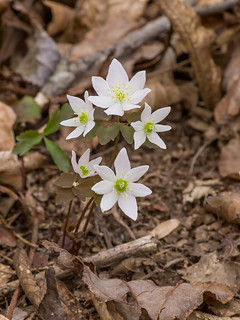 |
Arriving at the trail head, we donned our water-resistent jackets, strapped on our camera bags, and headed over to the base of the mountain. Alan, who was leading this field trip, said it would be just a “short walk” to the flowers. Well, it was a short walk, but he failed to mention that it was straight up a slick, muddy hill.
Soon, we began to see a couple of flowering plants along the trail, but Alan suggested that we proceed on to reach the “motherload” of this rare plant. Not used to climbing muddy hills with a heavy backpack and slick-bottom boots, I was constantly grabbing for tree trunks and roots, attempting to not humiliate myself by falling back down the trail.
After climbing another hundred feet or so up the mountain, we arrived at the first of several scattered populations of blooming plants. They were all marked and identified by colorful survey flags. These flags identified each plant by number. This number undoubtedly appears on some list or inventory so that their growth and flowering can be more easily monitored.
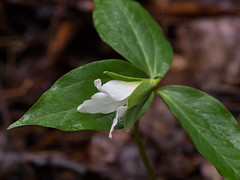 |
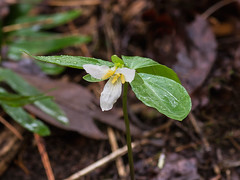 |
The other thing that Alan failed to tell me was that they were growing on a slope of at least 45 degrees! Standing on such a slope and trying to traverse between the groups of plants was more an exercise of tightrope walking than anything else. The entire time I was trying to set up my tripod and focus on a particular flower, I was sliding back down the mountain…
With rain water dripping off my nose and chin, I positioned my tripod on a particularly photogenic plant and immediately lost my footing, landing prostrate in the muddy leaves. Looking around to see if Alan or Steve had seen me slip, I was gratified to see that they were busy with their own balancing acts.
 |
 |
The flowers naturally tend to droop a bit, and to get a shot into the inside of the flower, the camera has to be practically on the ground. This was not as much of a problem as it seems though, since the steepness of the slope meant that all one had to do was look uphill, and the inside of the drooping flower could be seen easlily.
After a little while, we saw a group of six or seven students from Georgia Southern University climbing up the steep slope. Turns out, they were there to monitor the flowering. It was good to see that these plants were being protected and cared for. We exchanged pleasantries and resumed our photographic work:
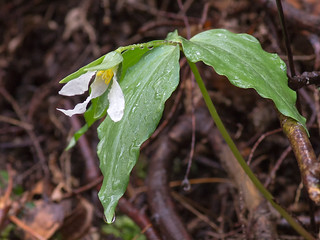 |
 |
After wandering around, climbing farther up the mountain to check out another group of plants, I finally found two plants which were close enough to be placed in a single photograph:
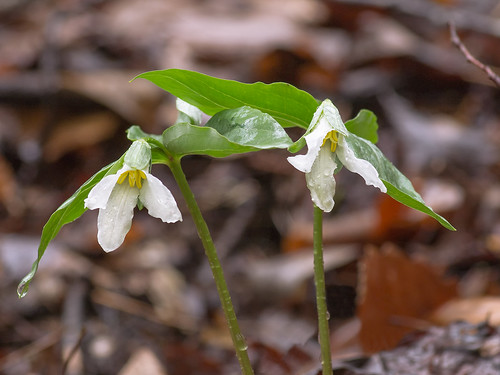
By this time Alan and Steve had had it with the rain and cold, so they backtracked down the mountain to the parking lot. I packed up and spent a little time talking to the researchers before I attempted to navigate my way back down the mountain without slipping and sliding. That was not to be, because there was one especially tricky part of the trail where I completely lost my balance and tried as gracefully as possible to maintain my dignity while I tumbled about ten feet in the mud and leaves, landing in a heap at the base of a small oak tree.
All’s well that ends well though. What a great trip. I managed to photograph a Trillium species that I had, to that point, only read about. It is extremely rare, and I probably won’t get another chance to see it again any time soon. The lead student researcher told me that the plant is not able to be pollinated until the petals turn pink and the pollen matures on the stamens. That will be another week to ten days, and although I’d like to go back to photograph it again, I will have several other trips to take and other flowers to study and photograph…
— Jim


0 Responses
Another great entry, Jim. Seems we both fulfilled a long time desire to see a rare Trillium this weekend. I finally saw and photographed Snow Trillium. Now, winter weather advisories and 3-5 inches snow on top of the ice we got today. I also saw a lecture on Federal endangered species and how they are monitored. A trip was made to see Running Buffalo Clover which was not blooming, but I could not make that trip. Keep the entries coming, I am enjoying every one.
Great write-up and a fascinating species that I’d like to see some day.
You got some really nice photos yesterday despite the nasty weather. I actually forgot how steep and slick that slope would be. The only other time I was there it wasn’t raining so it wasn’t so slick. Oh well, the adventure continues…
Thanks, Alan! It was an interesting hike… I really appreciate your taking us in to that site. When I think of how rare those plants are, the slipping and sliding becomes insignificant. I thought it would be fun to tell the story, though.
Jim, the whole time I was reading about all your excitement on the slick hill was,”How did you protect your camera from all the rain and still get such breathtaking photos?”
Thanks for the good words about my photographs! My Olympus E-5 is rainproof. In fact, when I was in the desert Southwest a year or so ago, I slipped and fell into a ditch, and half the camera was coated with thick, red mud. When I got back to the motel that afternoon, I took the camera with me into the shower. A good spray of water and towel dry, and it was a clean as new!
The Persistent Trilliums are in bloom today 4/11/15 at Tallulah Gorge and have turned purple so, they won’t be there long.
Enjoyed reading this. Stumbled upon it as I am exploring what to photograph at Tallulah Gorge. I am from Illinois and visiting friends in Suwanee. Heading up there on a rainy morning. With any luck I’ll have a slippery awkward experience like you but come away with pictures of a vey rare flower.